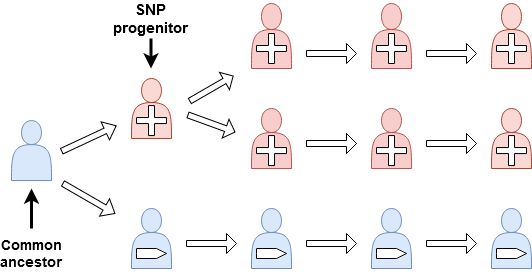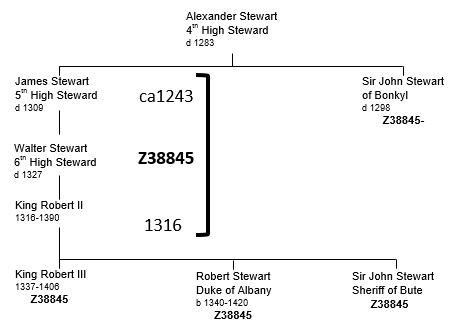The estimation of when stable genetic markers known as single nucleotide polymorphisms (SNPs – pronounced ‘snips’) were formed in the Y-DNA of ancestral lines is of great importance to genetic genealogists, as they attempt to establish when different lines of descent were formed. This can allow Y-DNA test takers to discover which branch of a family or clan they descend from and thus greatly enhance their genealogical research. Statistically based calculations can provide estimates of dates of formation, but our research aims to reach conclusions founded on DNA and documentary evidence.
Multi-generational SNP dating
Newer sequencing tests such as Big Y-700 offered by Family Tree DNA, or whole genome sequencing (WGS) tests now offered by several companies, read some 14-23 million locations rather than just short tandem repeat (STR) markers. With such extensive sequencing, mutations that have occurred between generations can now be identified. A mutation on the Y-chromosome within the portions sequenced by the Big Y-700 is calculated to occur on average every 83 years, based on data from the YDNA Warehouse.
It is often the case that the number of generations within which a SNP must have been formed can be refined, as further tests reveal new positive and negative results, splitting up the blocks of SNPs at branching points, thus allowing what we have termed multi-generational SNP dating.
Moving beyond this stage, if certain strict criteria are met it is possible to identify SNP progenitors.
Identifying a SNP progenitor
Present day test takers with well documented descents allow us to identify named people as SNP progenitors, individuals who lived in the past and in whom specific SNPs can be shown to have been formed. This can be done by evaluating test results from multiple surviving male lines of a family.

A SNP progenitor is an individual in whom a SNP was formed. This can be confirmed if tests on male line descendants of two or more of his sons are found to be positive for the SNP and tests of male line descendants of at least one of his brothers are found to be negative for the SNP. The first demonstrates that the SNP must have formed in the father of the two sons at the latest, while if a brother is negative for the SNP it could not have been formed in the proposed progenitor's own father.
Thus, if only one descendant line carries a particular SNP and the others do not, the founder of the line is known as the SNP progenitor. In other words, the SNP must have occurred in him and all his male descendants carry it, so belonging to his branch of the family or lineage.
A positive outcome of identifying SNP progenitors and the use of multi-generational SNP dating, is the possibility that this may improve and refine the statistically based model of SNP dating.
In the future, the discovery of SNPs that indicate branching, the more accurate dating of SNPs and the identification of SNP progenitors will benefit those whose genealogy halts due to lack of documentary evidence. Therefore, opportunity now exists to connect a brick walled lineage to a medieval genealogy beyond reasonable doubt.
SNP progenitor list
In order to compile a list of SNP progenitors, for the benefit of DNA Project administrators and individual researchers of specific surnames, we are now seeking suitable submissions which meet certain rigorous genealogical and genetic criteria.
The genetic criteria can be outlined as follows –
- male line descendants of two or more sons must be positive for a particular SNP marker
- a male line descendant of at least one brother must be negative for the SNP marker
These genetic criteria must also be supported by accompanying documentary evidence, showing the descents of the test takers from the relevant lineages. This information should all be verified by the individual or organisation submitting the SNP progenitor for potential addition to the list, but need not be supplied as part of the submission process.
The criteria should be evident from the SNP progenitor submission form we have created and we would very much welcome any contributions of data to build up a list of SNP progenitors. The cut-off date should be a birth date of at least one hundred years before the present. If you have any candidates for addition, please fill in the SNP progenitor submission form. The current version of the SNP progenitor list can be accessed here. Note that the FTDNA age estimates which are linked from this list, are based on statistical analysis of SNP and STR test results on the FTDNA website. They do not provide definitive dates for the creation of SNPs as our list does. Also please be aware that the responsibility for the accuracy of SNP progenitor information lies with the submitters.
The identification of SNP progenitors will make it possible for test takers carrying the associated SNP to know with confidence that they are male line descendants of this named historical individual, even if they have little documentary evidence. This will in turn allow these test takers to identify a specific branch of a clan or family to which they belong.
The Multi-generational SNP dates spreadsheet
This spreadsheet (linked below), provides our current data and conclusions on the likely time spans within which various SNPs were formed. A number of individual sheets for specific surnames detail the potential SNP progenitors for each SNP listed in the left hand column, along with information on which lines of descent have been DNA tested to provide the evidence for the conclusions. A SNPs sheet holds the data on the position of the SNPs on the Y chromosome, the mutation which identifies each SNP and the earliest and latest predicted dates of their formation.
Currently, very few certain SNP progenitors have been confirmed, but, once this number increases, our aim is to collect data on and make a list of SNP progenitors available linked from this webpage.
If you wish to submit data to be considered for inclusion on the Multi-generational SNP dates spreadsheet or the planned List of SNP progenitors please contact us on the e-mail addresses provided above.
View Multi-generational SNP dates spreadsheet
